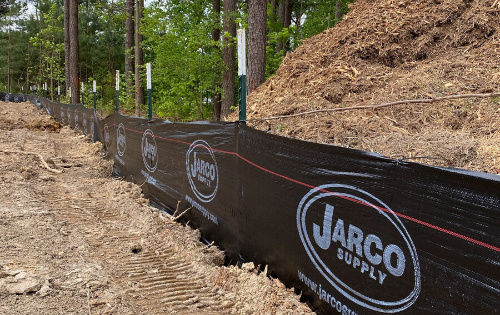Securing Your Website with Memphis Erosion Control Solutions silt fences
Wiki Article
Ideal Practices for Erosion Control in Construction Projects
Are you working on a construction project and worried about disintegration control? In this post, we will assist you with the ideal techniques for protecting against erosion on your site. hydroseeding. Obtain all set to tackle erosion head-on and make certain the success of your construction task.5 Crucial Disintegration Control Strategies

To effectively regulate erosion on your construction site, you'll require to execute important strategies such as slope stablizing and debris control procedures. Slope stabilization is important in preventing dirt erosion on high inclines. You can attain this by making use of methods like terracing, which includes creating horizontal steps on the slope to decrease water flow and advertise the absorption of rain. One more efficient method is the use of erosion control coverings or floor coverings, which are positioned on the slope and help maintain dirt bits while enabling greenery to expand. Sediment control steps are likewise important to avoid debris runoff into close-by water bodies. One effective technique is the setup of silt fencings along the perimeter of the building and construction website. These fencings act as barriers, recording sediment-laden water and enabling it to work out prior to it gets to the water bodies. Additionally, you can use sediment basins, which are temporary retention fish ponds designed to trap sediment and enable water to slowly drain off. Executing these crucial disintegration control strategies will certainly assist lessen the adverse environmental effect of your construction task and ensure compliance with regulations.
Reliable Debris and Drainage Monitoring

You can properly take care of sediment and overflow in your construction task by applying appropriate disintegration control measures. Another vital practice is the application of erosion control coverings or mats. By applying these erosion control procedures, you can efficiently manage sediment and overflow in your building and construction job, lessening the effect on the environment and conforming with governing demands.
Key Considerations for Slope Stabilization
You need to thoroughly take a look at the incline's features, such as its make-up, angle, and drainage patterns. Look for indications of disintegration, such as exposed roots, splits, or down dirt.When you have recognized the unstable locations, you can start applying steps to maintain the incline. One typical method is the use of retaining wall surfaces or terracing to produce a series of level steps, which can aid distribute the weight and protect against further erosion. Another choice is to plant plants on the slope, as the roots can aid anchor the soil and control disintegration. In addition, installing erosion control blankets go to my blog or floor coverings can give prompt defense while greenery becomes established.
It's essential to frequently keep track of the supported slopes to ensure their performance. Watch out for any indications of movement or erosion, and take immediate activity if needed. Normal maintenance, such as checking and repairing any type of broken measures, is also vital to ensure long-lasting security.
Best Practices for Plants and Dirt Security
One reliable way to safeguard greenery and soil on slopes is by regularly checking for signs of disintegration and taking immediate activity if needed. Begin by evaluating the slope for any type of indicators of erosion, such as subjected roots, bare soil patches, or debris build-up at the bottom. Implement erosion control measures such as mounting erosion control coverings, mulching, or even creating retaining wall surfaces if required.Carrying Out Proper Water Drainage Equipments
When it comes to taking care of water flow and protecting against erosion, recognizing these elements is crucial. Steeper inclines can lead to faster water circulation, raising the danger of disintegration and flooding. On the other hand, gentler inclines allow water to move extra gradually, decreasing erosion potential.Dirt kind likewise affects drainage system layout. Different soil types have varying degrees of leaks in the structure, influencing just how water is absorbed and drained pipes. Sandy dirts often tend to drain pipes faster due to their coarse structure, while clay dirts have a slower drainage rate due to their small nature. Comprehending the dirt kind aids in choosing appropriate drainage methods, such as utilizing absorptive materials or setting up French drains pipes. Additionally, considering the dirt qualities aids protect against waterlogging, which can cause gardening and landscaping services near me inadequate plant growth and damage to structures.
Conclusion
To conclude, when it involves disintegration control in building projects, you need to adhere to these best methods. Carry out my company effective debris and drainage monitoring techniques to avoid air pollution. Think about incline stablizing techniques to make sure the stability of the site. Protect greenery and dirt by utilizing ideal steps. Develop appropriate drain systems to take care of water circulation (Memphis Erosion Control Solutions Memphis TN). By complying with these important methods, you can properly manage disintegration and make certain the success of your construction task.To efficiently regulate erosion on your building and construction site, you'll need to implement crucial strategies such as incline stabilization and debris control procedures. Incline stabilization is crucial in avoiding dirt disintegration on steep inclines. An additional reliable technique is the use of disintegration control coverings or mats, which are put on the slope and assistance retain soil fragments while allowing greenery to expand. Another choice is to plant greenery on the incline, as the roots can aid secure the soil and control erosion. Implement erosion control steps such as mounting erosion control blankets, mulching, or even building maintaining wall surfaces if needed.
Report this wiki page